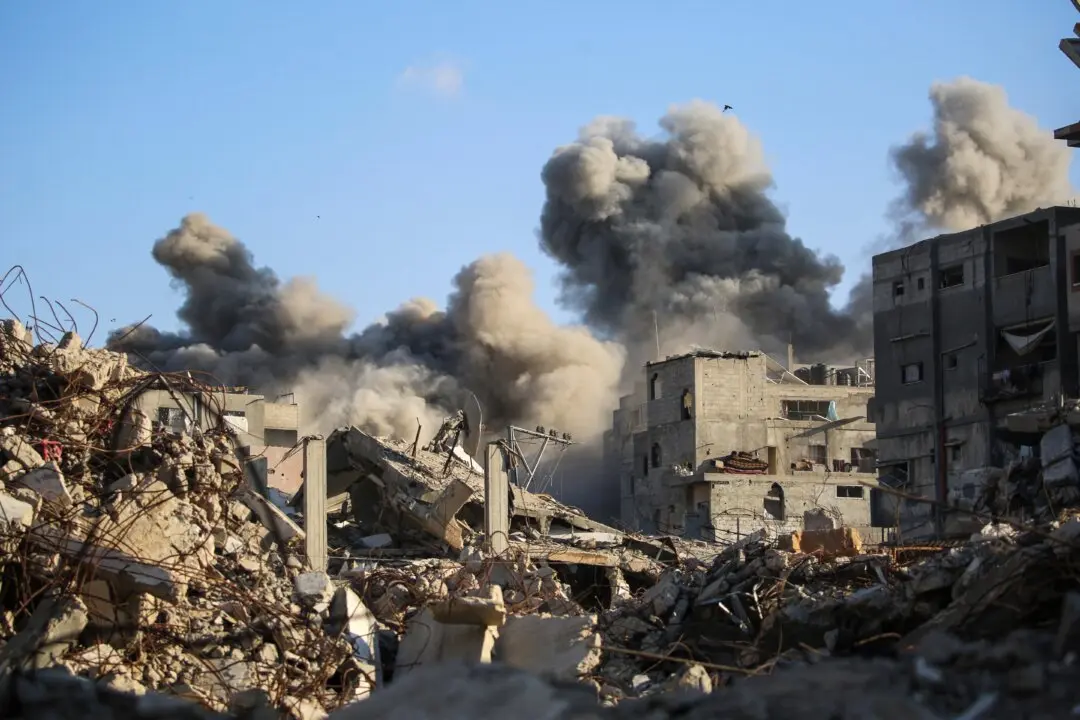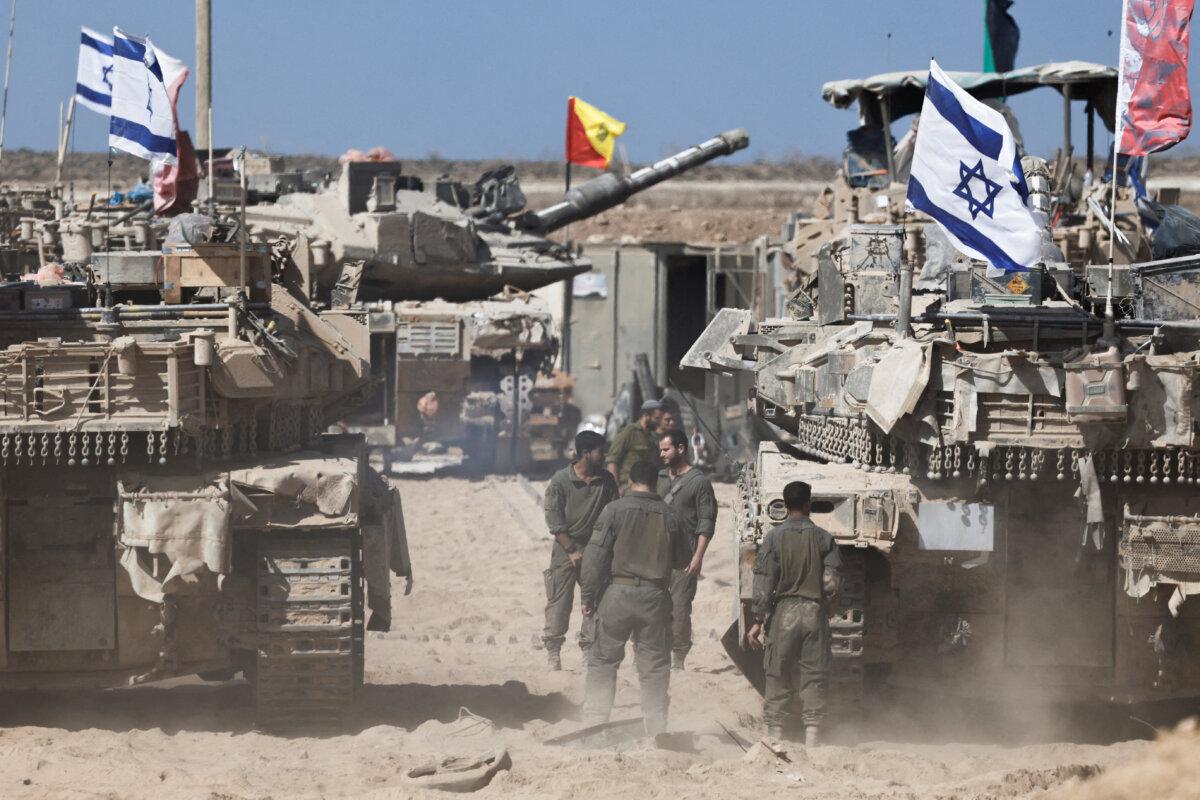The violation occurred in the Rafah area, the Israeli military said.

Smoke billows following an Israeli strike in the central Gaza Strip on Oct. 19, 2025. Eyad Baba/AFP via Getty Images
The Israeli military said on Oct. 19 that Hamas violated the cease-fire by firing an anti-tank missile at Israeli Defense Forces (IDF) operating in the Rafah area.
The IDF said it responded with strikes in the area to eliminate the threat and dismantle the tunnel shafts and military structures the Hamas terrorist group was using.
“These terrorist actions constitute a blatant violation of the ceasefire agreement, and the IDF will respond firmly,” the IDF said on Sunday.
Hamas-controlled Gaza health authorities said that two Palestinians were killed in Israel’s airstrikes in the eastern Jabalia area of northern Gaza.
The Times of Israel reported that the military was carrying out airstrikes in the Rafah area after Hamas attacked forces there.
Israeli Prime Minister Benjamin Netanyahu said Israel will retaliate forcefully to any Hamas’ attacks on its soldiers.
Trump: US Will ‘Go In’ If Hamas Killings Continue in Gaza; Cuomo, Mamdani Debate for NYC Mayor | Capitol Report
The prime minister held consultations with Israel’s security heads and ordered the military to take “strong action” against any violations of the cease-fire. However, his office did not threaten to return to war.
In a statement, Hamas’ armed wing claimed it was still committed to the cease-fire agreement throughout Gaza, it was not aware of clashes in Rafah, and it had fallen out of contact with groups in that area since March.
“We affirm our full commitment to implementing all agreements, foremost among them the cease-fire across all areas of the Gaza Strip,” the Al-Qassam Brigades said.

Israeli soldiers stand next to tanks near the Israel-Gaza border, in Israel, Oct. 19, 2025. Amir Cohen/Reuters
The U.S. State Department put Hamas on notice on Saturday, citing “credible reports” that the Iran-backed terror group was planning an imminent attack on Palestinians civilians, in violation of the peace agreement.
A State Department spokesperson said that should Hamas proceed with its “planned attack against Palestinian civilians” and violate the cease-fire, the United States and other guarantors of the peace agreement would respond.
The guarantors demand Hamas uphold its obligations under the ceasefire terms,” the notice read.
“The United States and the other guarantors remain resolute in our commitment to ensuring the safety of civilians, maintaining calm on the ground, and advancing peace and prosperity for the people of Gaza and the region as a whole.”
No further details were disclosed. The notice was issued amid reports of violence and shootings in Gaza between Hamas and rival factions.
Hamas on Sunday morning rejected the statement from the U.S. State Department, saying the allegations were false.
Hamas had launched a security crackdown in urban areas vacated by Israeli forces, demonstrating its power on the enclave through public executions and clashes with local armed clans.
A Hamas official on Oct. 16 defended the killings that reportedly started on Oct. 13, and video footage of the public executions circulated online.
Speaking in Beirut, Hamas’ political representative in Lebanon Ahmed Abdul-Hadi said the individuals who were killed “caused death and corruption in Gaza and killed displaced persons and aid seekers.”
Hadi said the decision to sentence them “was done by a Palestinian national and tribal consensus.”
Obstacles to Peace
The cease-fire agreement was signed by Israel and Hamas on Oct. 9, securing the first stage of a multi-step agreement to end a two-year war between Israel and Hamas.
Three days later, the cease-fire held, with Hamas living up to part of its agreement to release the 20 living hostages it was holding in Gaza. In return, Israel released close to 2,000 Palestinian detainees and convicted prisoners jailed in Israel.
However, the deadline for Hamas to return the bodies of 28 hostages who had died and were also being held in Gaza expired on Oct. 13. The United States noted it did not view the delay as Hamas’s violation of the deal, noting challenges in locating and retrieving the bodies.
Hamas has assured the United States through intermediaries that it’s working to return dead hostages. It says that the remaining bodies are buried in tunnels that were destroyed by Israel, and that heavy machinery is needed to dig through the rubble to retrieve them.
The delays have seen the two sides accuse each other of cease-fire violations, with Israeli Prime Minister Benjamin Netanyahu threatening to cut aid to Gaza if the bodies are not returned immediately. Throughout the war, Israel’s military has exhumed bodies as part of its search for the remains of hostages.
Israel announced on Oct. 16 it was preparing to reopen Gaza’s Rafah border crossing with Egypt to allow Palestinians to move in and out, but gave no date as it said that Hamas remained in violation of its promise to return the missing hostage bodies.
On Oct. 18, Netanyahu said the Rafah crossing would remain closed, and its reopening is dependent on Hamas handing over the remaining bodies of deceased hostages.
Later in the day, Israel acknowledged receiving two more bodies, marking 12 out of 28 bodies to be returned. So far, Israel has also returned to Gaza 90 bodies of dead Palestinians.
Hamas said in a statement that Netanyahu’s decision to close the crossing “constitutes a blatant violation of the ceasefire agreement and a repudiation of the commitments he made to the mediators and guarantor parties.”
It said the closure would prevent the entry of equipment needed to search for and locate more hostage bodies under the rubble, further delaying the recovery and handover of the remains.
‘Not Playing Games’
Architect of the peace agreement President Donald Trump, on Oct. 14, assured reporters during a press conference with Argentinian President Javier Milei that Hamas would lay down its arms.
“They know I’m not playing games,” he said.
Trump also said that Hamas had taken out “a couple of gangs that were very bad.”
“And they killed a number of gang members. And that didn’t bother me much, to be honest with you,” he said.
Trump then clarified later the same day that he wouldn’t be sending U.S. troops into Gaza.
“It’s not going to be us,” he told reporters. “We won’t have to. There are people very close, very nearby that will go in and they’ll do the trick very easily, but under our auspices.”
On Oct. 15, U.S. Central Command (CENTCOM)—the U.S. military’s Middle East command—urged Hamas to cease violence “without delay.”
“We strongly urge Hamas to immediately suspend violence and shooting at innocent Palestinian civilians in Gaza,” Commander Brad Cooper, head of CENTCOM, said in a statement. “We have conveyed our concerns to the mediators who agreed to work with us to enforce the peace and protect innocent Gaza civilians.”
Trump warned again on Oct. 16 in a social media post that “if Hamas continues to kill people in Gaza, which was not the Deal, we will have no choice but to go in and kill them.”
Reuters and The Associated Press contributed to this report.
Jacob Burg reports on national politics, aerospace, and aviation for The Epoch Times. He previously covered sports, regional politics, and breaking news for the Sarasota Herald Tribune.Melanie Sun is a reporter and editor covering world news. She has a background in environmental research.

